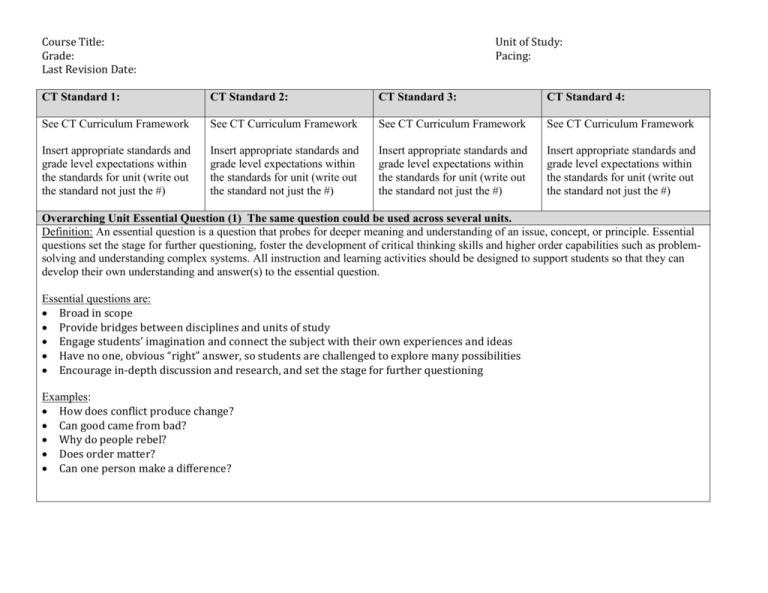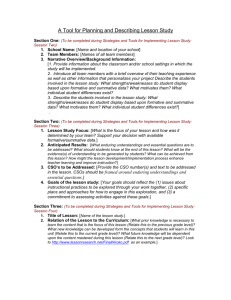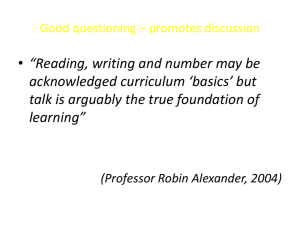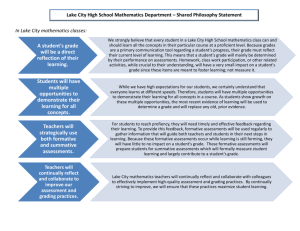CT Standard 1:
advertisement

Course Title: Grade: Last Revision Date: Unit of Study: Pacing: CT Standard 1: CT Standard 2: CT Standard 3: CT Standard 4: See CT Curriculum Framework See CT Curriculum Framework See CT Curriculum Framework See CT Curriculum Framework Insert appropriate standards and grade level expectations within the standards for unit (write out the standard not just the #) Insert appropriate standards and grade level expectations within the standards for unit (write out the standard not just the #) Insert appropriate standards and grade level expectations within the standards for unit (write out the standard not just the #) Insert appropriate standards and grade level expectations within the standards for unit (write out the standard not just the #) Overarching Unit Essential Question (1) The same question could be used across several units. Definition: An essential question is a question that probes for deeper meaning and understanding of an issue, concept, or principle. Essential questions set the stage for further questioning, foster the development of critical thinking skills and higher order capabilities such as problemsolving and understanding complex systems. All instruction and learning activities should be designed to support students so that they can develop their own understanding and answer(s) to the essential question. Essential questions are: Broad in scope Provide bridges between disciplines and units of study Engage students’ imagination and connect the subject with their own experiences and ideas Have no one, obvious “right” answer, so students are challenged to explore many possibilities Encourage in-depth discussion and research, and set the stage for further questioning Examples: How does conflict produce change? Can good came from bad? Why do people rebel? Does order matter? Can one person make a difference? Course Title: Grade: Last Revision Date: Big Ideas/Enduring Understandings: Definition: Big Ideas/Enduring Understandings are statements summarizing important ideas and core processes that are central to a discipline and have lasting value beyond the classroom. They synthesize what students should understand—not just know or do—as a result of studying a particular content area. Moreover, they articulate what students should “revisit” over the course of their lifetimes in relationship to the content area. Enduring Understandings: provide a conceptual foundation for studying the content area and are deliberately framed as declarative sentences that present major curriculum generalizations and recurrent ideas o contain statements beginning with “Students will understand that….” “unpack” areas of the curriculum where students may struggle to gain understanding or demonstrate misunderstandings and misconceptions can transfer to other fields as well as adult life Example: Students will understand that conflict produces change both positively and negatively Unit of Study: Pacing: Unit Guiding Questions: Definition: Guiding Questions direct what students study and investigate about a subject’s enduring concepts, important generalizations, critical content items, and processes and skills. Guiding Questions: are tied to a specific topic or unit of study are open-ended, there is no “single” answer require a well-reasoned response and can be argued are generative in nature: they spark inquiry and raise other questions are recurring questions that can and should be revisited lead students to the Big Ideas, or Enduring Understandings and core processes Examples: How does stress on the environment impact evolution? War? How were changes in economics a factor in the Civil Course Title: Grade: Last Revision Date: Unit of Study: Pacing: What content will students know? (nouns) What skills will students be able to do? (verbs) Vocabulary/Concepts: Vocabulary & Concepts that are necessary to master content standards and develop response(s) to the essential question. Universal & content-specific skills that students are expected to demonstrate during and by the conclusion of the unit. Supporting Information (People, Places, & Facts): Supporting information necessary to develop an understanding of content standards and response(s) to the essential question. Skills should scaffold from knowledge to evaluation on Bloom’s Taxonomy. Course Title: Grade: Last Revision Date: Unit of Study: Pacing: Differentiated of Instruction: The process of “ensuring that what a student learns, how he/she learns it, and how the student demonstrates what he/she has learned is a match for that student’s readiness level, interests, and preferred mode of learning” (Tomlinson as cited in Elis, Gable, Greg, & Rock, 2008, p. 32). Possible Instructional Strategies: (modeling, scaffolding, grouping, materials, learning styles, delivery method, etc.) Possible Instructional Extensions: Definition: Learning activities that challenge students above and beyond the general scope of the unit of study. Activities can be alternate assignments, inquiry challenges, creation of a new product based on recent learning, or a unique student generated idea that demonstrates higher order learning and skill. Possible Instructional Support: Definition: Learning activities/materials that can assist a student through the additional organization of information or by scaffolding content and skills instruction addressing individual student needs in a more explicit manner. Activities/materials can include graphic organizers, additional modeling or guided practice activities, or adapted assignments that allow for demonstration and learning and skill, relative to ability. Further Strategies and Objectives for ELL’s ESL instruction is to be focused on oral language, reading and writing through concept development based on regular classroom objectives. All modifications are based upon grade level standards with appropriate tasks geared toward grade level content standards. Enhanced Word Walls Adapt Reading Selections Teach in Reverse Provide Sentence Starters Controlled Speech Bilingual Resources Models and Rubrics Audiovisuals, Cues, Organizers Use Primary Language Resources Front-Load, Embed, Blend, Review Course Title: Grade: Last Revision Date: Unit of Study: Pacing: Formative Assessments: Before: Common Formative Assessments (CFAs) are given to all students in a grade/content area to determine what students already know about the given topic or concept. During: Formative Assessments (FAs), or checks for understanding, can be developed collaboratively or individually. CFAs FOR learning are not used for grading purposes, the primary purpose is to provide feedback to teachers and students regarding the next step of learning. These shorter ongoing assessments, provide real-time information concerning whole class and individual understanding of a newly introduced topic or skill. FAs can be in the form of an exit ticket, a demonstrated answer/response in a journal or notebook, multiple choice questions, an open-ended response item, completion of a graph or web organizer, correct drawing or depiction of a character, lab result, mathematical equation, etc. End of Unit Summative Assessment: Definition: An assessment OF learning that demonstrates what students know and are able to do at the end of a unit. Assessments are explicitly designed to demonstrate knowledge of the enduring understanding and proficiency of the desired skills. These are typically given AFTER learning in a summative fashion, however may be used formatively to guide future learning as well. Assessments must contain a balance of content and skill related tasks as identified in the unit of study. During the course of a unit and throughout the academic year, students should engage in individual, partner and cooperative groups for assessments. The teacher identifies some assessments and students can choose others. These include a wide variety of assessments such as: written response oral presentations research papers debates multi-media presentations lab reports Formative/Summative Assessment Adaptations Examples for adapting assessments: • Provide word bank or specialized glossary • Reduce linguistic complexity without eliminating key vocabulary • Adapt number of items students are expected to complete Course Title: Unit of Study: Grade: Pacing: Last Revision Date: • Break tasks into chunks • Read directions and test questions aloud. Consider rephrasing when appropriate • Adapt amount of time for completion • Provide sample problems for each task type • Include pictures and graphic organizers used in lessons • Provide sentence stems or writing frames • Let students show mastery in different ways: verbal response, hands-on activities, models/visuals, sorting • Differentiate scoring by giving one score for content knowledge and another for language skills Use clear and consistent format for pencil and paper tests Course Title: Grade: Last Revision Date: Unit of Study: Pacing: Point of Relevance: Possible Talking Points: What is happening in the world NOW that will enable students to connect to this unit of study? Interdisciplinary Connections: What other disciplines, topics, studies, or career fields can be connected to this unit for interested students to explore? Is there something happening in my home, community, state, nation, or internationally that this relates to? Why is studying this topic important? Unit Resources: e-Resources: Literature Connections Primary Sources/Other Documents/Text







